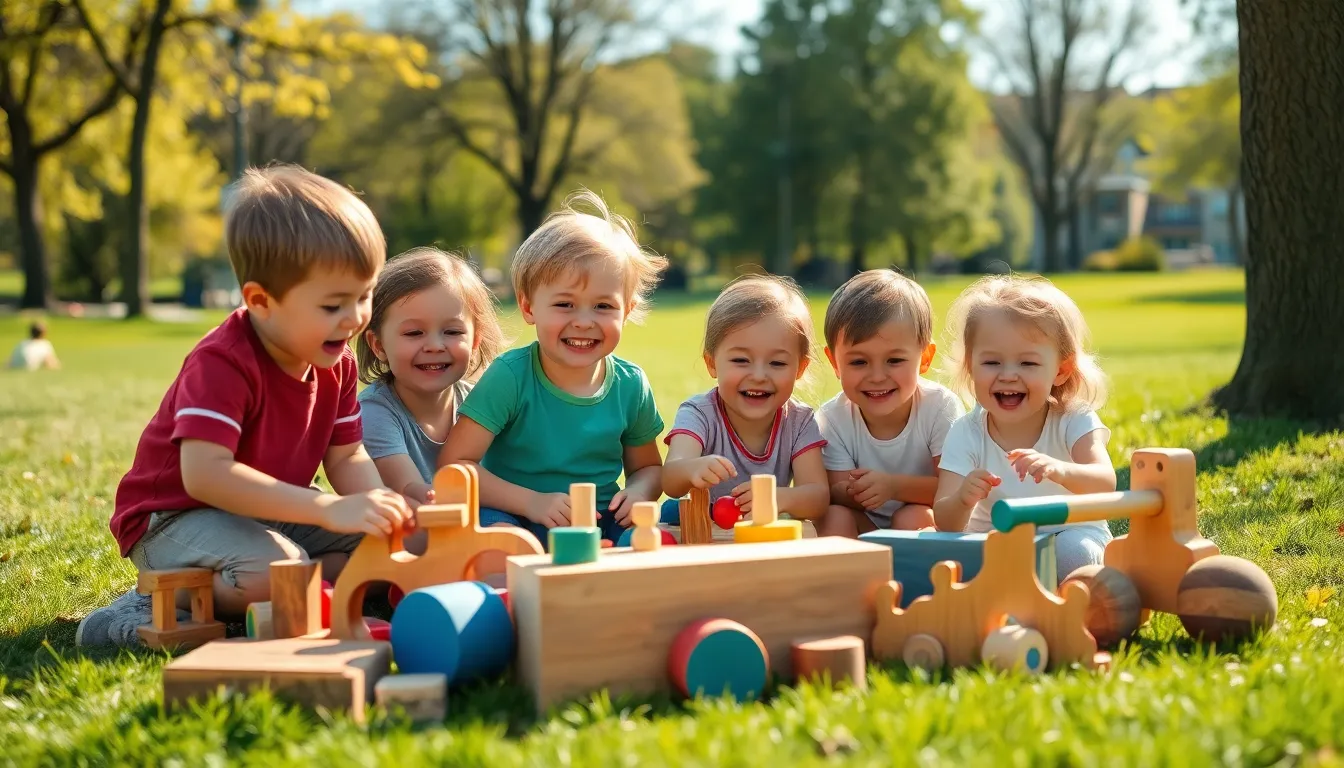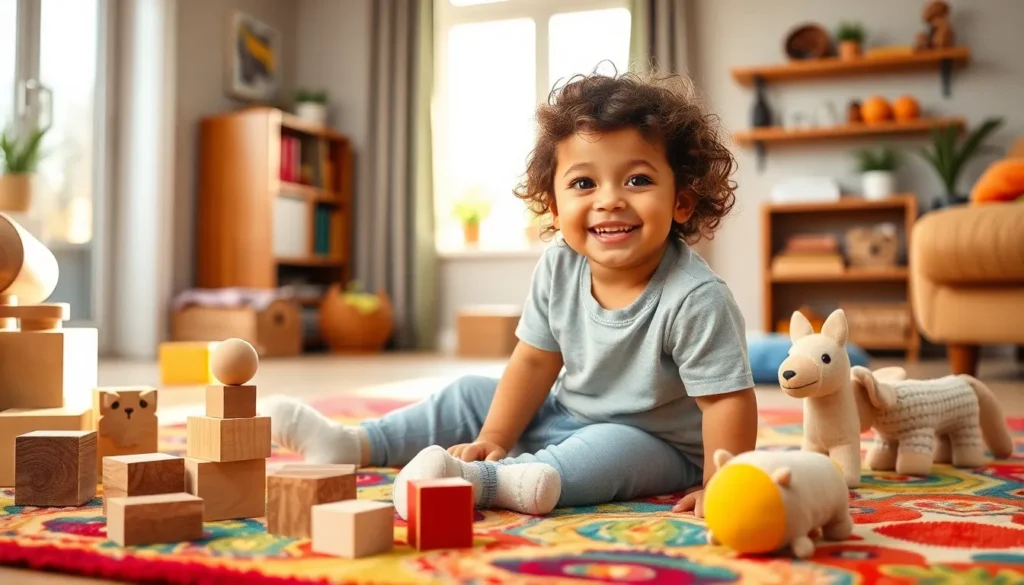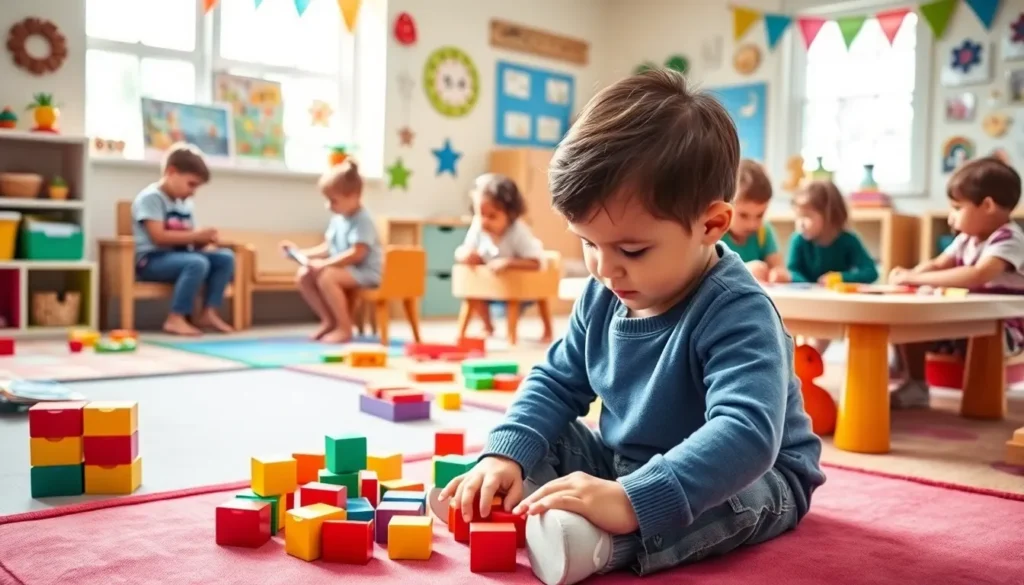In a world where plastic dinosaurs outnumber real ones, eco-friendly toys are here to save the day! These sustainable playthings not only spark joy but also help save the planet—talk about a win-win. Imagine your child building a fortress of imagination with toys that won’t contribute to the great ocean of plastic.
Table of Contents
ToggleWhat Are Eco-Friendly Toys?
Eco-friendly toys are products designed with sustainable materials and production processes that minimize environmental impact. These toys use natural resources, such as wood, organic cotton, and recycled materials, ensuring safer play for children and reducing waste.
Parents often prioritize safety and eco-friendliness when selecting toys. Non-toxic paints and dyes are common features in eco-friendly options. Manufacturers typically avoid harmful chemicals and plastics, reducing health risks associated with traditional toys.
Play patterns benefit from eco-friendly toys, as they encourage imaginative engagement and creativity. Rather than relying on electronic features, these toys often emphasize hands-on experiences. Classic options like wooden blocks or soft fabric dolls foster open-ended play, which promotes cognitive development in children.
Many companies focus on sustainable practices during the manufacturing process. Responsible sourcing of materials, eco-friendly packaging, and energy-efficient production methods contribute to their overall sustainability. Certifications and labels, such as FSC or GOTS, help identify authentic eco-friendly products on store shelves.
Environmental benefits span further than individual toys. Choosing sustainable options reduces plastic waste in landfills and oceans. Supporting eco-friendly brands strengthens the demand for environmentally responsible practices within the toy industry.
Ultimately, eco-friendly toys represent a blend of fun, safety, and sustainability. Families who choose them support both healthy childhood development and a cleaner planet. Engaging with eco-friendly toys inspires a new generation to appreciate and protect the environment.
Benefits of Eco-Friendly Toys

Eco-friendly toys offer significant advantages for both children and the environment. Parents increasingly choose these toys, appreciating their positive impacts on playtime and nature.
Environmental Impact
Eco-friendly toys play a crucial role in reducing plastic pollution. Crafted from materials like wood, organic cotton, and recycled resources, these alternatives help minimize waste. Manufacturers often adopt sustainable production processes, conserving energy and resources. By choosing eco-friendly toys, families contribute to a cleaner planet and promote responsible sourcing practices. According to a study by the American Society for Testing and Materials, switching to sustainable options can lower a household’s overall environmental footprint significantly. Supporting companies that prioritize eco-friendly initiatives fosters a market for greener products.
Safety for Children
Safety ranks as a top priority when selecting toys for children. Eco-friendly options typically avoid harmful chemicals and toxic paints, promoting healthier play experiences. Non-toxic materials ensure peace of mind for parents, knowing that their children engage with safe products. Studies demonstrate that children are less likely to encounter hazards associated with plastic toys, which often contain undisclosed materials. Compliance with safety certifications affirms a toy’s reliability, giving parents confidence in their choices. Ultimately, eco-friendly toys deliver both fun and safety, nurturing creativity while safeguarding children’s health.
Types of Eco-Friendly Toys
Various types of eco-friendly toys cater to different preferences and values. These sustainable alternatives provide safe and enjoyable experiences for children while minimizing environmental impact.
Wooden Toys
Wooden toys often feature natural materials sourced from sustainable forests. Children enjoy building blocks, puzzles, and vehicles crafted from wood, which offer durability and aesthetic appeal. Non-toxic finishes enhance safety, allowing kids to explore creativity without harmful substances. Manufacturers prioritize responsible sourcing and eco-friendly production techniques. Many wooden toys are designed to withstand vigorous play, extending their lifespan and reducing waste.
Organic Fabric Toys
Organic fabric toys utilize materials like organic cotton, free from harmful chemicals and pesticides. These toys often come in the form of plush animals, dolls, and soft blocks, appealing to younger children. Parents appreciate their hypoallergenic properties, making them safe for sensitive skin. Artisans often employ fair trade practices, promoting ethical craftsmanship. By opting for organic fabric toys, families support sustainable agriculture and contribute to safer play experiences.
Biodegradable Plastics
Biodegradable plastics, derived from renewable resources, offer an eco-friendly alternative to traditional plastic toys. These innovative materials break down more easily in landfills, reducing long-term environmental impact. Many toys made from biodegradable plastics maintain durability and safety standards, allowing for extended play while minimizing waste. Researchers focus on improving these materials’ properties to ensure they meet various safety certifications. Consumers increasingly favor biodegradable options, supporting the movement toward a cleaner planet.
Popular Brands Offering Eco-Friendly Toys
Several brands champion eco-friendly toys, making sustainable play options accessible to families.
Green Toys leads the pack with a range created from 100% recycled plastic. Known for their iconic products like trucks and dishes, these toys are both safe and durable.
PlanToys specializes in wooden toys made from sustainably sourced rubberwood. Their products encourage imaginative play while promoting environmental awareness through eco-conscious practices.
Hape focuses on creating non-toxic wooden toys designed to foster creativity and explore nature. Their commitment to sustainable materials highlights their dedication to eco-friendly craftsmanship.
Melissa & Doug features a selection of toys crafted from responsibly sourced wood and non-toxic finishes. They prioritize imaginative play, making their offerings a favorite among parents looking for safe options.
Bannor Toys provides beautifully handcrafted wooden toys that emphasize safe play and sustainability. Their dedication to ethical practices resonates with eco-conscious families.
Oompa Toys curates an extensive collection of eco-friendly toys spanning multiple materials, including organic cotton and wood. They focus on quality, safety, and durability, ensuring long-lasting enjoyment.
Bamboo Toys invests in producing toys from renewable bamboo, offering a unique alternative to traditional plastics while maintaining a playful charm.
Tender Leaf Toys incorporates sustainable practices into their production of wooden toys, ensuring children engage with safe, eco-friendly options. Their vibrant designs attract attention while promoting sustainability.
These brands exemplify the push towards greener alternatives in the toy industry, offering choices that benefit both children and the environment.
Tips for Choosing Eco-Friendly Toys
Selecting eco-friendly toys involves careful consideration of materials and manufacturing practices. Prioritize toys made from sustainably sourced wood, organic cotton, or recycled materials. Look for certification labels that ensure products meet safety and environmental standards. Check for non-toxic paints or finishes to guarantee safe play for children.
Examine the brand’s commitment to sustainability. Many reputable brands implement ethical practices, such as reducing waste and using eco-friendly packaging. Researching manufacturer policies can reveal their overall impact on the environment. Assess the durability of toys; longer-lasting products reduce replacement frequency and minimize waste.
Consider age-appropriateness; many eco-friendly toys cater to different developmental stages. Toys designed for specific age groups foster safe learning experiences. Ensure that the chosen toys encourage imaginative play and creativity, supporting cognitive growth.
Assess the packaging as well. Eco-friendly toys often come in minimal, recyclable packaging that reduces environmental footprints. Choose brands that prioritize responsible packaging solutions.
Evaluate the toy’s recyclability or biodegradability. These traits ensure less waste in landfills and promote a sustainable lifecycle. Opting for toys that can decompose or be recycled supports a cleaner planet.
Engaging with others can also provide insights. Join online forums or community groups focused on sustainable parenting to explore recommendations. Connecting with like-minded parents allows for sharing experiences with eco-friendly products.
Eco-friendly toys offer a delightful blend of fun and sustainability that benefits both children and the planet. By choosing toys made from sustainable materials, parents can nurture their child’s creativity while minimizing environmental impact. The shift towards eco-friendly options not only fosters healthier play experiences but also supports a market that prioritizes ethical production practices.
With a growing number of brands committed to sustainability, families have access to a wide range of safe and engaging toys. This conscious choice empowers parents to contribute to a cleaner environment while enriching their child’s developmental journey. Embracing eco-friendly toys is a step towards a brighter future for generations to come.




